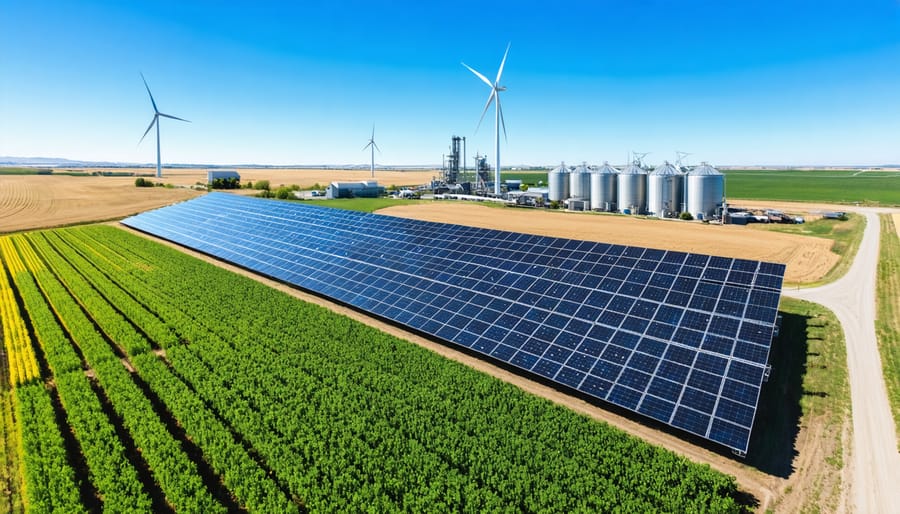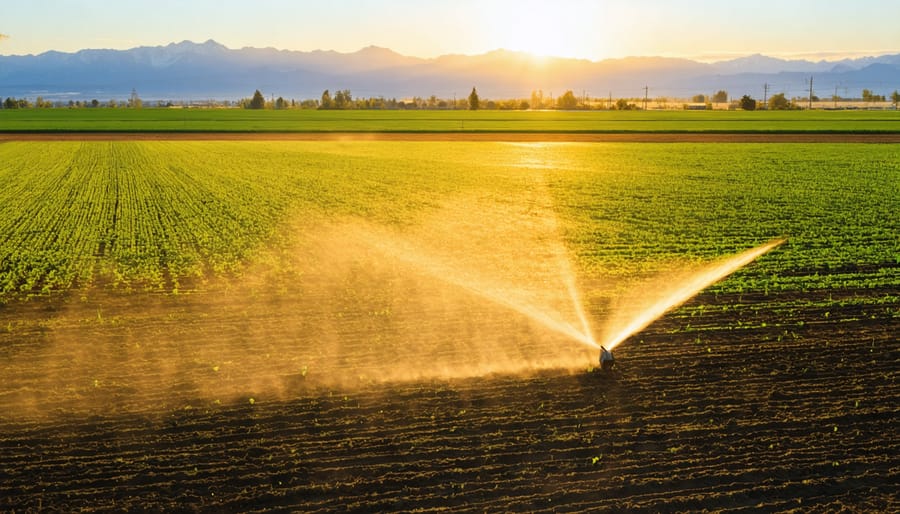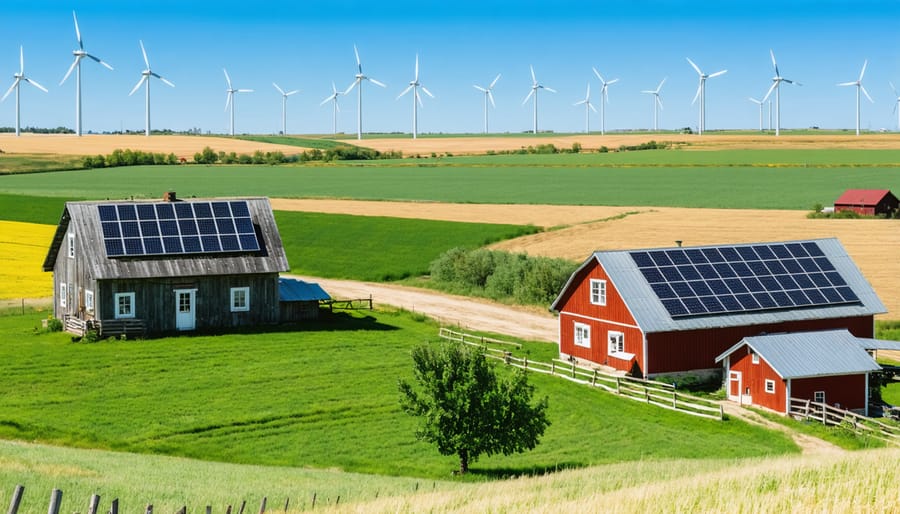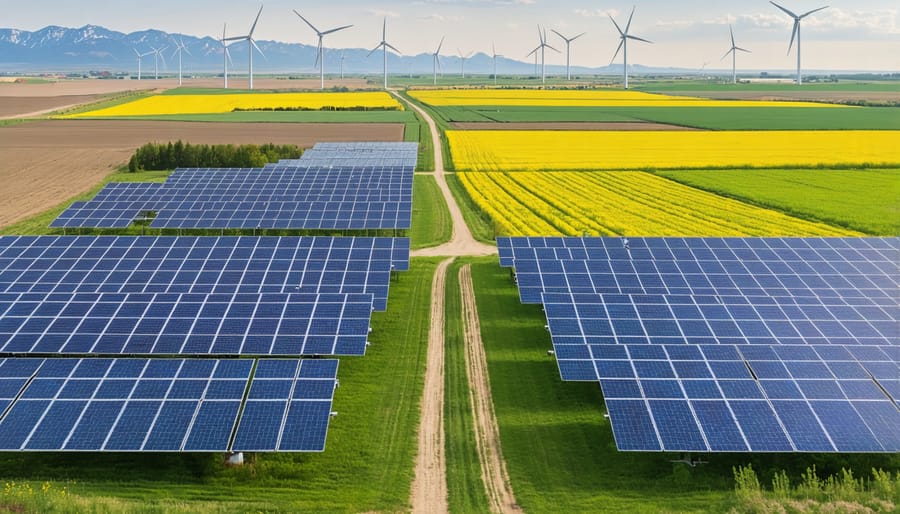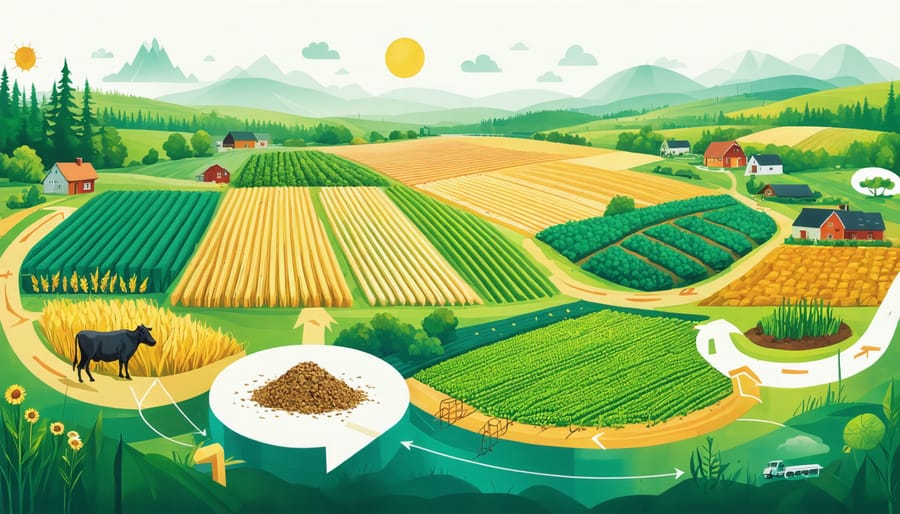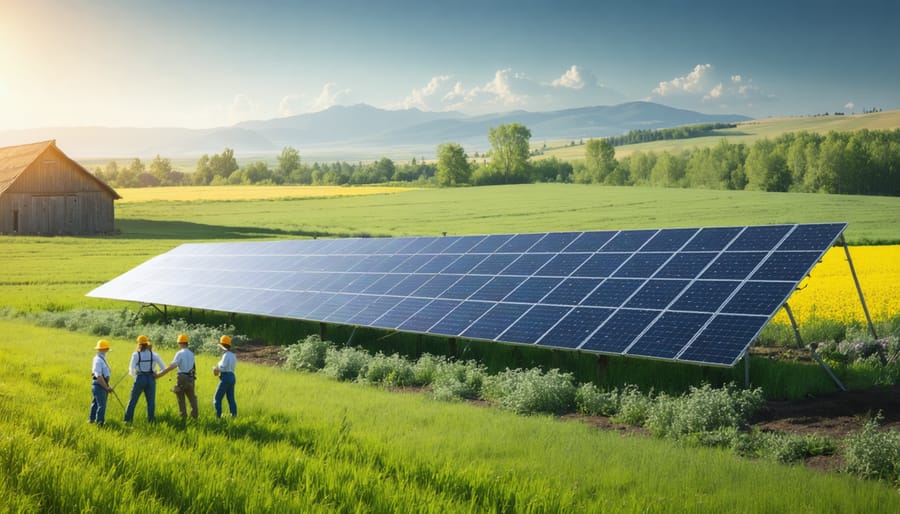Transform your agricultural operation into a renewable energy powerhouse through three proven resources that are reshaping Alberta’s farming landscape. Solar panels, wind turbines, and biomass systems have emerged as leading climate-smart community projects delivering both environmental and economic benefits to Canadian farmers.
These renewable solutions offer practical advantages uniquely suited to our agricultural regions: solar installations can offset irrigation pump costs while utilizing unused roof space, wind energy captures Alberta’s abundant prairie winds while allowing continued crop production beneath turbines, and biomass systems convert agricultural waste into valuable heating fuel and soil amendments.
With government incentives, decreasing technology costs, and established success stories across the province, implementing these renewable energy systems has never been more achievable for farming operations. Local agricultural cooperatives are already demonstrating how these technologies can reduce operational costs by 40-60% while creating new revenue streams through power generation.
[Word count: 121]
Solar Farming: Growing Energy Alongside Crops
Dual-Use Land Management
Across Alberta’s prairies, innovative farmers are discovering that they don’t have to choose between energy production and traditional agriculture. By implementing agrivoltaic systems, they’re successfully growing crops and generating solar power on the same land.
Take Sarah Thompson’s farm near Lethbridge, for example. She installed elevated solar panels that allow enough sunlight through for her wheat crops while providing partial shade that reduces water evaporation. “We’ve actually seen improved yields in some drought-prone areas,” Thompson shares, “and the extra income from power generation helps stabilize our farm revenue.”
The key to successful dual-use management lies in proper spacing and orientation of solar arrays. Panels mounted 3 to 4 metres high allow farm equipment to pass underneath easily, while east-west tracking systems maximize both energy capture and crop exposure to sunlight. Some Alberta farmers are even using the spaces between panel rows for grazing sheep, which naturally maintain vegetation growth.
Local agricultural extension services report that certain crops, particularly shade-tolerant varieties like leafy greens and root vegetables, thrive under partial solar coverage. During the intense summer months, the panels’ shade can reduce plant stress and water consumption by up to 30%.
The Alberta Renewable Energy Cooperative has been instrumental in helping farmers assess their land’s potential for dual-use projects. They provide free consultations and connect farmers with local installers who understand agricultural needs. Through their program, farmers can start small with a pilot project and expand based on results.
Currently, over 25 farms in southern Alberta are successfully combining solar energy with traditional farming, proving that renewable energy and agriculture can work hand in hand to create more resilient farm operations.
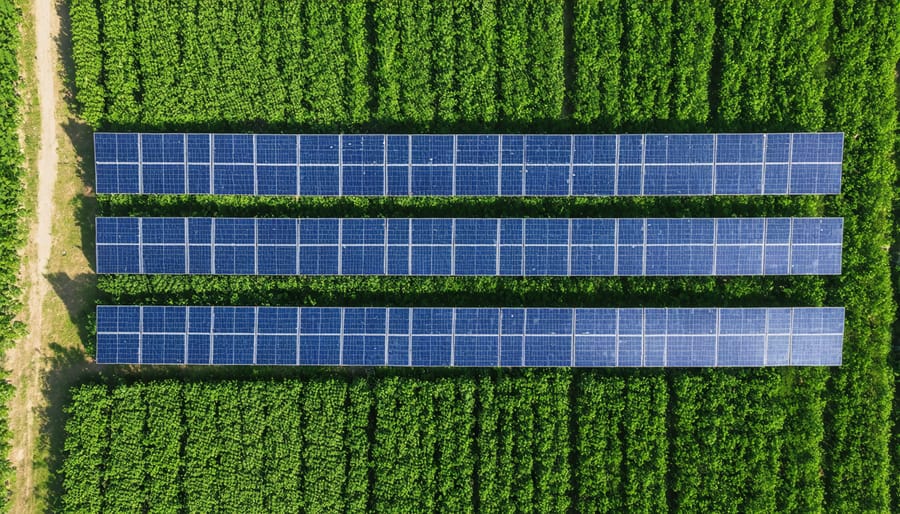
Community Solar Success Stories
Alberta’s renewable energy landscape has been transformed by successful community solar projects, with several inspiring examples leading the way. The Town of Raymond made headlines in 2019 by becoming Alberta’s first net-zero municipality, installing solar panels on all municipal buildings. This initiative now generates 1.5 megawatts of power annually, saving the community approximately $150,000 in energy costs each year.
In Vulcan County, the Western Canada Sustainability Initiative brought together 25 local farmers to create a 2-megawatt solar farm on previously unused agricultural land. The project now powers over 300 homes while providing participating farmers with steady additional income through power generation.
The Medicine Hat Community Solar Co-operative demonstrates the power of collective action. Starting with just 12 members in 2018, the co-operative has grown to include 75 participants who jointly operate a 1-megawatt solar installation. Members receive quarterly dividends based on energy production, with average returns of 5-7% annually.
Perhaps most notably, the Starland County Agricultural Solar Project has become a model for agricultural solar integration. Local farmer Sarah Thompson shares, “We’ve maintained full crop production while generating clean energy. The panels actually help with snow retention and soil moisture management.” The project generates 640 kilowatts of power while allowing for continued farming operations underneath the elevated panels.
These success stories showcase how solar initiatives can strengthen community bonds while providing both environmental and economic benefits to rural Alberta communities.
Wind Energy: Harvesting Prairie Power
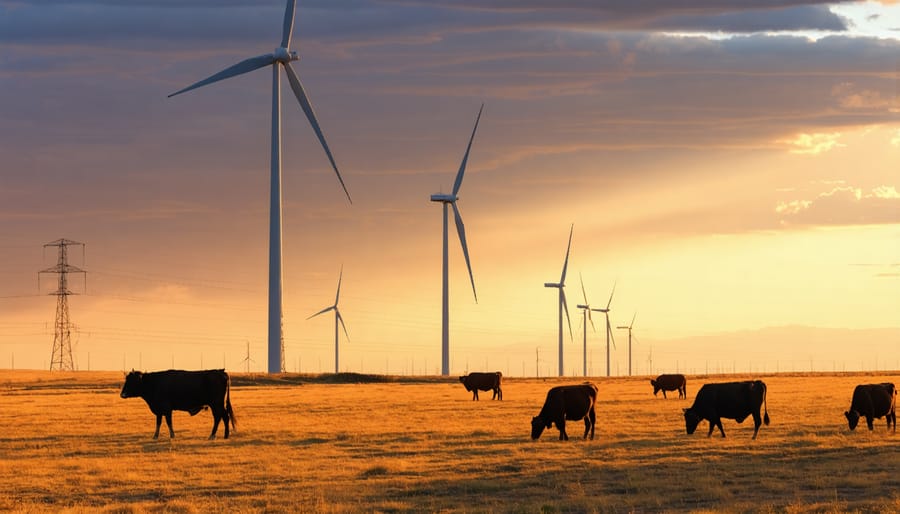
Small-Scale Wind Solutions
Small-scale wind solutions have become increasingly popular among Alberta farmers, offering a practical and efficient way to harness natural energy resources. These systems, typically ranging from 1 to 50 kilowatts in capacity, are particularly well-suited for farms with average wind speeds of 15 kilometres per hour or higher.
Take the Thompson family farm near Pincher Creek, for example. Their 10-kilowatt turbine generates enough power to run their dairy operation’s milking equipment and cold storage, saving them approximately $3,000 annually on electricity costs. The initial investment of $40,000 was offset by provincial renewable energy grants, making the project financially viable with a payback period of 8-10 years.
For rural communities considering wind energy, micro-grid systems have proven especially effective. These systems allow multiple properties to share the benefits of wind power while distributing the installation and maintenance costs. The Mountain View County Wind Co-op demonstrates this approach, with 15 local farms collaborating on a shared 100-kilowatt system.
When implementing small-scale wind solutions, consider these practical factors:
– Available space (turbines typically need 0.5 to 1 hectare of clear land)
– Average wind speeds in your area
– Distance to existing power lines
– Local zoning regulations
– Wildlife impact assessments
Modern small-scale turbines are designed to operate quietly and require minimal maintenance, typically just annual inspections. Many Alberta suppliers now offer comprehensive installation services, including site assessment, permits, and ongoing maintenance support.
For farmers interested in exploring wind energy, the Alberta Agriculture Energy Solutions program provides free consultations and can connect you with local experts and funding opportunities.
Cooperative Wind Projects
Across Alberta’s prairies, farming communities are discovering the power of collective action through cooperative wind energy projects. By pooling resources and sharing costs, rural neighbors are making wind power more accessible and economically viable for everyone involved. These initiatives are part of a broader movement of farmers tackling climate change while building stronger communities.
The Pincher Creek Wind Farm Cooperative serves as an inspiring example, where 12 local farming families joined forces to install three 2.3 MW turbines. By sharing the initial investment of $4.2 million, each family contributed what they could afford while receiving proportional returns on energy production. The project now powers over 900 homes and provides supplemental income for participating farms.
Creating a wind cooperative typically begins with a feasibility study to assess wind resources and potential environmental impacts. Local agricultural organizations often provide guidance through the planning process, helping communities navigate regulations and secure funding through programs like the Alberta Community Generation Capacity Building Program.
Key benefits of cooperative wind projects include reduced individual financial risk, shared maintenance responsibilities, and stronger bargaining power with utility companies. Many farming communities report that these initiatives have strengthened neighborly bonds and created new opportunities for knowledge sharing about sustainable practices.
For farmers considering joining or starting a wind cooperative, the Alberta Farmers’ Renewable Energy Network offers workshops and connects interested parties with successful projects. Their resources include templates for cooperative agreements, funding guides, and technical assistance for getting started.
Biomass: Converting Agricultural Waste to Energy
On-Farm Biomass Systems
Biomass energy systems represent a practical and sustainable solution for Alberta’s farming operations, turning agricultural waste into valuable energy resources. Local farmer Dave Thompson from Red Deer County shares, “Converting our crop residue and livestock waste into energy has not only reduced our operational costs but also solved our waste management challenges.”
Common on-farm biomass sources include crop residues, animal manure, and wood waste from shelterbelts. These materials can be processed through various methods, including anaerobic digestion and direct combustion, to produce heat, electricity, and even vehicle fuel.
The Bergmann family farm near Olds demonstrates the effectiveness of these systems. Their 250-hectare operation uses a biomass boiler system that processes straw and corn stalks to heat their greenhouse operations and barn facilities, saving approximately $15,000 annually in heating costs.
For livestock operations, anaerobic digesters offer dual benefits: waste management and energy production. These systems can process manure from as few as 150 dairy cows to generate enough electricity for basic farm operations. The resulting digestate also serves as a nutrient-rich fertilizer, creating a closed-loop system that benefits both crop and livestock operations.
Getting started with biomass energy doesn’t require massive infrastructure. Many Alberta farmers begin with simple biomass heating systems for individual buildings, gradually expanding as they become comfortable with the technology. Local agricultural extension offices provide support and guidance for farmers interested in implementing these systems, including information about available grants and technical assistance.
Important considerations include ensuring a consistent biomass supply, proper storage facilities, and regular system maintenance. The initial investment varies but typically ranges from $50,000 to $200,000, depending on system size and complexity.
Community-Scale Biogas Projects
Alberta’s agricultural communities are leading the way in community-scale biogas initiatives, with several successful projects demonstrating the potential of this renewable energy source. The Lethbridge Biogas LP facility stands as a prime example, processing over 100,000 tonnes of organic waste annually from local farms and food processors, generating enough electricity to power 2,800 homes while providing valuable fertilizer for nearby crops.
In Red Deer County, the Growing Power Hairy Hill project has created a circular economy model where local farmers supply agricultural waste to the biogas facility. The facility not only generates clean energy but also produces high-quality organic fertilizer that farmers can use on their fields, creating a sustainable cycle of resource use.
The success of these initiatives has inspired new community-led projects across the province. In Mountain View County, a group of dairy farmers has pooled resources to create a cooperative biogas facility that processes manure from multiple farms. This collaborative approach has made the project more economically viable while reducing individual farm operating costs.
These projects showcase the multiple benefits of community biogas initiatives: reduced greenhouse gas emissions, improved waste management, and additional revenue streams for farmers. Local agricultural extension offices report that participating farms have seen a 15-30% reduction in fertilizer costs through the use of digestate byproducts.
For communities considering similar projects, the Alberta Biogas Association offers guidance and connects interested parties with successful operators willing to share their experiences. The provincial government also provides funding support through the Rural Economic Development Initiative, making these projects more accessible to farming communities.
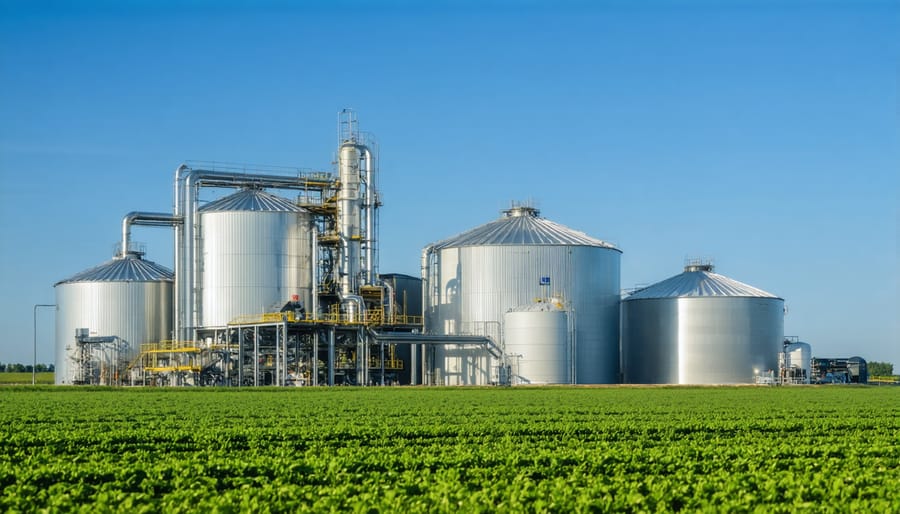
In embracing solar, wind, and biomass energy solutions, Alberta’s farming communities have a unique opportunity to lead Canada’s renewable energy transition. These sustainable resources not only reduce operational costs but also strengthen our agricultural sector’s resilience and environmental stewardship. By participating in community-powered solutions, farmers can share resources, knowledge, and infrastructure while building a more sustainable future for generations to come. Whether it’s joining a solar cooperative, participating in wind farm projects, or developing biomass initiatives, every contribution matters. Together, we can create a robust renewable energy network that supports both agricultural productivity and environmental conservation. Let’s take the next step toward energy independence and sustainability by exploring these renewable options for your farm today.

